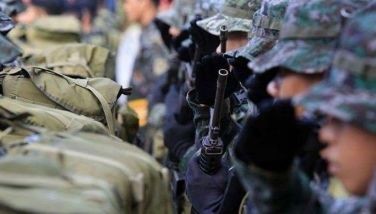Public transport shortfall feared

MANILA, Philippines — Commuters should brace for a possible shortfall in transport services beginning tomorrow as more businesses reopen and more people are expected to go out with the easing of quarantine restrictions in Metro Manila and several other areas, Transportation Secretary Arthur Tugade said at a virtual press briefing yesterday.
He said that with Metro Manila and some urban centers being placed under general community quarantine (GCQ) starting tomorrow, the Department of Transportation (DOTr) would have to strike a balance between providing relief to commuters and helping prevent the spread of the coronavirus disease 2019 (COVID-19).
“Although we know that the mandate of the Department of Transportation is to provide mobility and connectivity in the spirit of convenience to passengers, we are also aware of our responsibility at present to help in preventing the spread of COVID-19. That is why we need to balance the need for transportation and taking care of our health and safety,” Tugade explained.
Trains, taxis, transport network vehicle service, shuttle services and point-to-point buses will be allowed to operate with limited passenger capacity starting tomorrow. Jeepneys are still not allowed to ferry commuters.
“Definitely there will be a discrepancy, that is why what we are telling the public is if you are not a person allowed to travel, do not travel. We should really expect that our public transportation will be limited,” DOTr assistant secretary Mark de Leon said.
Undersecretary for administrative service Artemio Tuazon, DOTr’s official representative to the Inter Agency Task Force for the Management of Emerging Infectious Diseases (IATF), said employers or businesses are not advised to open if they cannot provide shuttle services or housing for their workers.
“The IATF encourages all employers who will operate to provide either shuttle to their employees or house them in a site near their offices so they will not have to travel far,” Tuazon said.
“Now, if they cannot do that, if they cannot provide these to their employees, then IATF is saying that they should not open yet,” he said.
The DOTr, however, is putting in place a more efficient system to address the demand for public transportation while the GCQ is in place, according to De Leon.
He said these include putting dedicated lanes along EDSA and rationalizing routes for more effective traffic management, among others.
Rail capacity cut
By tomorrow, Tugade said the LRT-1, LRT-2, MRT-3 and Philippine National Railways (PNR) trains would be operational with limited passenger capacity.
He said PNR would operate at 25 to 30 percent capacity, while MRT-3, LRT-1 and LRT-2 would have a limited capacity of between 12 and 14 percent.
The number of trains servicing MRT-3, however, will increase to 19 from the normal 14 or 15, with the addition of China-made Dalian trains.
“This is because Sumitomo has agreed to include three Dalian trains that is why by Monday, expect that the trains that will run for the MRT-3 are 19,” Tugade said.
Tugade said passengers should also expect faster train speed of 40 kilometers per hour on several parts of the MRT-3 line with the recent completion of some of the rail replacement activities.
“In that way, we will be able to increase rides and those who can ride despite the limited capacity,” the transport chief said.
For LRT-1, 28 trains will be running, while a total of five trains will be servicing LRT-2.
As for the PNR, eight trains will be running, all of which are the new units manufactured in Indonesia.
To help address the limited capacities of the trains, a bus augmentation system would be put in place.
“According to the DOTr rail sector, they need 90 buses. Since we are helping the rail sector of DOTr and they said that is the requirement, so we will provide that,” Land Transportation Franchising Regulatory Board chairman Martin Delgra said.
There will be no change in the operating schedule of MRT-3, with its first departure from North Ave. station at 5 a.m. and from Taft Ave. at 5:24 a.m. Last departure from North Ave. is 9:10 p.m. and from Taft Ave. station at 10:04 p.m.
PNR, however, will expand its operating hours with an earlier start of 3 a.m. to accommodate those who want to come to work early. Last trip will be at 8:20 p.m.
Tugade said the agency has deployed marshals who, together with police and traffic personnel, would enforce health and safety protocols.
For the rail sector, DOTr undersecretary for railways Timothy John Batan said a technology based solution would be rolled out for contact tracing.
“For contact tracing, the approach we are looking at for the rail sector is to use the app which has been approved by the IATF, which is StaySafe. We have an ongoing discussion with StaySafe and eventually that is what we will roll out,” Batan said.
Construction of bus stops and pedestrian overpasses along EDSA would support the EDSA bus program.
- Latest
- Trending






























